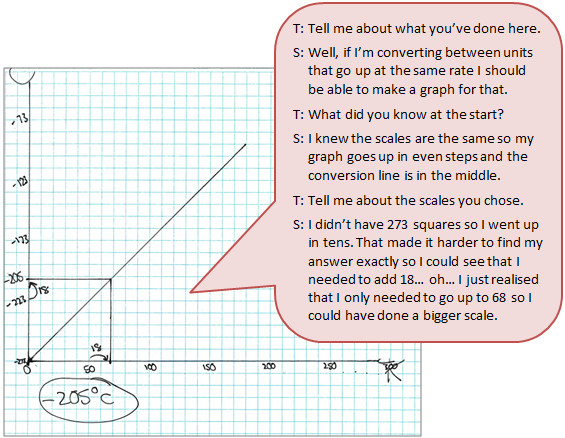Going bananas
The purpose of this activity is to engage students in solving problems using integer values.
This activity assumes the students have experience in the following areas:
- Using a number line to represent operations on numbers.
- Adding and subtracting integers.
- Representing integers on a number line.
The problem is sufficiently open ended to allow the students freedom of choice in their approach. It may be scaffolded with guidance that leads to a solution, and/or the students might be given the opportunity to solve the problem independently.
The example responses at the end of the resource give an indication of the kind of response to expect from students who approach the problem in particular ways.

To make a frozen banana dessert, Mad Martha drops a banana into a flask of liquid nitrogen, which she measures to be at a temperature of 68°K.
The Kelvin, K, is a unit of temperature that starts at zero (which is the same temperature as -273°C) and goes up at the same rate as degrees Celsius.
What is the temperature of the liquid nitrogen in the flask, in degrees Celsius?
The following prompts illustrate how this activity can be structured around the phases of the Mathematics Investigation Cycle.
Make sense
Introduce the problem. Allow students time to read it and discuss in pairs or small groups.
- Do I understand the situation and the words? (Students may not be familiar with the Kelvin scale for temperature. The term “at the same rate” means that the scales have a one-to-one correspondence.)
- What do you know and what don’t you know? (The liquid nitrogen temperature is 68⁰K, and 0⁰K = -273⁰K.)
- What will my solution look like? (The solution will be the temperature of the liquid nitrogen in degrees Kelvin.)
Plan approach
Discuss ideas about how to solve the problem. Emphasise that, in the planning phase, you want students to say how they would solve the problem, not to actually solve it.
- Where will I start? What do I need to do first? (Begin by considering temperatures below zero Celsius.)
- What strategies can I use to get started? (Drawing two number lines, one for each scale is a useful starting point.)
- Do I have a sense of the likely temperature of liquid nitrogen in degrees Kelvin? Estimate the range of values it could lie between.
- Could I choose a sensible starting temperature for both scales? How can I show that -273⁰K = 0⁰C? How far away from that benchmark is the temperature of the nitrogen?
- What tools will I use? (A calculator may be useful and graphing software might make representation easier.)
Take action
Allow students time to work through their strategy and find a solution to the problem.
- Am I recording my workings in a systematic way so others could follow them?
- Is my strategy working or do I need to change tack?
- Are there other ways to solve the problem, such as creating an equation with the numbers?
- Does my answer seem correct? Could I check by working backwards?
- Is there another possible answer or way to solve it? Can I be more efficient?
Convince yourself and others
Allow students time to check their answers and then either have them pair share with other groups or ask for volunteers to share their solution with the class.
- What is the solution? Can I show that the solution is correct? How?
- Is my working clear for someone else to follow?
- What is the best representation to show the answer?
- How would I convince someone else I am correct?
- Could I have solved the problem in a more efficient way?
- Have I considered all the information?
- What connections can I see to other situations? How do the scales Kelvin, Celsius, and Fahrenheit relate?
Examples of work
Work sample 1
The student forms and solves appropriate equations with integers in order to find the solution to the problem.
Click on the image to enlarge it. Click again to close.
Work sample 2
The student finds a method solves a problem with integers. The student uses visual representations of negative numbers, such as number lines, graphs or thermometer diagrams.

